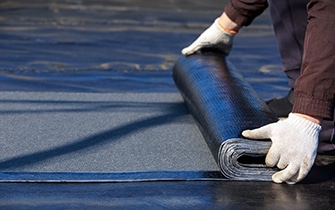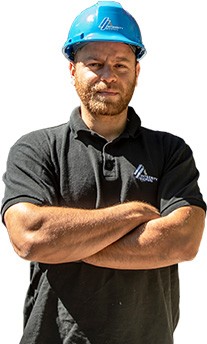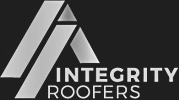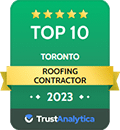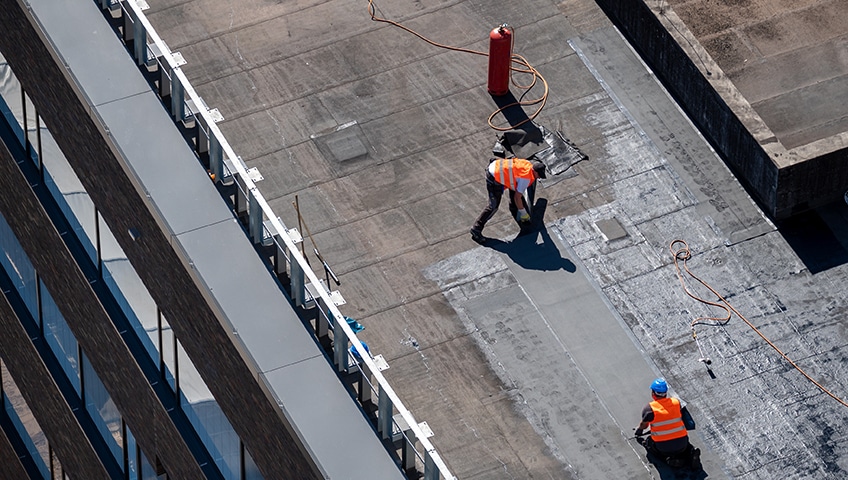
Your Essential Guide to Flat Roof Coatings
March 5, 2024
A roof coating plays a pivotal role in protecting and extending the lifespan of your roof. It provides enhanced UV protection, mitigates contraction and expansion cycles that could lead to premature membrane failure, and prevents water ponding issues. Opting for a roof coating is often more cost-efficient than a full roof replacement. Yet, choosing the right coating depends on several factors, including your roof’s location, condition, slope, and exposure to various elements like heat, chemicals, and UV rays. With a variety of coatings available, it’s crucial to weigh their pros and cons to find the best fit for your roof.
Common Pros and Cons of Flat Roof Coatings
Advantages
- Increased Reflectivity: Reflective roof coatings are designed to reflect more sunlight and absorb less heat than traditional roofing materials. This feature is particularly beneficial for buildings in warmer climates as it can significantly reduce cooling costs. By reflecting UV rays, these coatings help maintain cooler roof surfaces, reducing the heat transferred into the building. This not only prolongs the life of the roof by preventing overheating and UV damage but also contributes to a more comfortable indoor environment without heavily relying on air conditioning systems.
- Cost-Effective: Applying a roof coating is a cost-efficient way to extend the lifespan of an existing roof without the need for a full replacement. Roof coatings can seal leaks and minor damages, offering an affordable solution to enhance roof durability. This preventative maintenance can save significant money in the long term by avoiding costly emergency repairs and extending the time between roof replacements. Moreover, the energy savings from improved roof reflectivity add to the financial benefits by lowering utility bills.
- Weather Resistant: High-quality roof coatings are engineered to withstand extreme weather conditions, including heavy rain, strong winds, and fluctuating temperatures. They create a seamless barrier that is resistant to moisture penetration, helping to prevent leaks and water damage. Additionally, these coatings can expand and contract with the roof materials during temperature changes, reducing the risk of cracks and splits in the roof surface. This elasticity makes them an excellent option for protecting the roof from weather-induced wear and tear.
Disadvantages
- Ponding Water: One of the primary challenges with flat roof coatings is their potential struggle with ponding water. Flat roofs are inherently more susceptible to water accumulation due to their minimal slope. Some roof coatings might not be fully effective in preventing water penetration in areas where water tends to pool for extended periods. Prolonged exposure to standing water can degrade the coating, leading to leaks and reducing the overall effectiveness of the roof’s protective barrier. It’s crucial for the coating application to be carefully planned and executed to mitigate these risks, including ensuring proper drainage is in place.
- Loss Of Reflectivity: While many roof coatings are initially highly reflective, their ability to reflect UV rays can diminish over time. Factors contributing to this loss include the accumulation of dirt, debris, and other particulates that settle on the roof surface. As the coating becomes dirty, its reflectivity decreases, which can lead to higher surface temperatures and reduced energy efficiency within the building. Regular maintenance and cleaning are essential to preserve the reflective qualities of the coating and ensure it continues to provide energy-saving benefits.
- Holds Dirt: Roof coatings, particularly those with a tacky or sticky finish, can attract and hold dirt, leaves, and other debris. This not only affects the aesthetic appearance of the roof but can also impact its functionality. The accumulation of debris can hinder the roof’s drainage system, potentially leading to water pooling and the associated problems it brings. Moreover, a dirty roof coating may require more frequent cleaning to maintain its reflectivity and performance, adding to maintenance costs.
Strengths and Weaknesses of Different Flat Roof Coatings
- Acrylic Roof Coatings: Acrylic coatings are water-based, making them environmentally friendly and easy to apply. They offer excellent reflectivity, reducing cooling costs by deflecting UV rays. Acrylic coatings are best suited for regions with moderate weather, as extreme cold can make them less flexible and more susceptible to cracking. Over time, weathering can thin out the coating, necessitating reapplication to maintain effectiveness.
- Silicone Roof Coatings: Silicone coatings are known for their exceptional water resistance and ability to withstand ponding water without degrading, making them ideal for flat roofs where water accumulation is a concern. They maintain their reflectivity over time, even in dirty conditions, due to their inert nature. However, silicone can attract dirt and may become slippery when wet. While durable, silicone coatings are more expensive and may require special preparations for recoating.
- Polyurethane Roof Coatings: These coatings are highly resistant to physical damage and foot traffic, making them suitable for roofs accessed more frequently. There are two main types: aromatic (less UV stable and cheaper) and aliphatic (more UV stable and more expensive). Polyurethane coatings provide excellent water resistance but can be more difficult to apply due to their sensitivity to moisture during application.
- Spray Foam: Spray polyurethane foam (SPF) offers both insulation and waterproofing, making it a versatile choice for roof coatings. It creates a seamless layer that can improve a building’s energy efficiency significantly. However, SPF must be applied by professionals and requires precise conditions for application. It’s also essential to have a protective top coat to shield the foam from UV rays and physical damage.
- Thermoplastic Roof Coating (TPO & PVC): Thermoplastic coatings, such as TPO (Thermoplastic Olefin) and PVC (Polyvinyl Chloride), are highly reflective and resistant to UV light, chemicals, and punctures. They’re especially suited for commercial applications due to their durability and low maintenance requirements. The installation of thermoplastic coatings requires skilled roofing contractors and heat welding equipment, potentially increasing the initial cost.
Roof Coating vs Roof Replacement
Roof Coating: A viable option for extending the life of your roof without the high costs associated with a full replacement. Ideal for roofs that are in generally good condition but may need enhanced protection and minor repairs.
Roof Replacement: Necessary when a roof is beyond repair. Though more expensive, it offers a long-term solution for roofs that suffer from significant damage or are nearing the end of their lifespan.
Consult Reliable Commercial Flat Roof Contractors for the Best Solution
